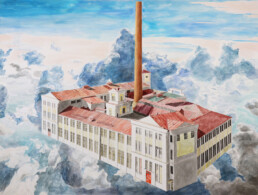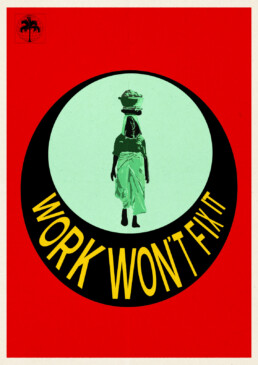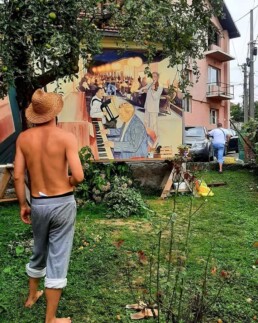Spaces for art and artists, new perspective on work and jobs at the present moment, dialogue between participants on the artistic and cultural scene, the less visible artists, social and climate changes; these are some of the topics that are present in works and performances which will be presented at this year’s edition of the October Salon.
During this year’s 60th edition of the October Salon, from October 20 to December 1, exhibitions and accompanying programs will take place, as usual, in several locations – the galleries of the Cultural Center of Belgrade, the Pavilion in Cvetni trg, the Gallery of the Faculty of Fine Arts (FLU), the former Akademija club, the Gallery of the Association of Fine Artists of Serbia (ULUS), the Gallery of the Union of Fine Artists of Yugoslavia (SULUJ), Salon of the Museum of the City of Belgrade, Museum of African Art, windows of the French Institute and public spaces in the city.
We spoke with curators Dobrila Denegri, Maja Kolaric, Ana Knezevic and Emilia Epstajn about cooperation with foreign curators and about art works which they would like to highlight within the three concepts that are the pillars of this year’s edition of the Salon.
On Friday, October 18, before the official opening of the October Salon, the artistic duo of Lucy and Jorge Orta will introduce us to the program and themes through a performance in front of the Cultural Center of Belgrade. This work should be an invitation to dialogue between artists, the city’s cultural scene and the structures that determine cultural policy at the local and state level. As Dobrila Denegri, art historian and curator, who worked on the Trace concept with Lorenzo Balbi, director of the Museum of Modern Art in Bologna – MAMbo, explains, these artists have been affirmed since the mid-90s with their engaged approach that problematizes the critical issues of today: climate change , danger of droughts, migration, and processes of social integration, coexistence and equality. “We decided to present the 47th version of their collective performative act, entitled 7×70 – Meal, as a form of a peaceful protest, with the idea that ‘sitting at the same table, sharing bread and food’ can be a way of drawing attention to some of the burning problems faced by artists and cultural workers in our country.”
Lorenzo’s concept for the Trace segment is based on the proposal to invest the entire budget of the manifestation in the purchase of a building that would be used as an exhibition space for the October Salon, which never had its own space. Such a facility would remain available for artists and art even after the event. However, the October Salon takes place, like years before, in several locations, so the concept was transformed. “Almost all the interventions that we have included in our October Salon segment have a similar message: it is necessary to create spaces where artists can create, and which can become humus for a more prosperous artistic and cultural scene. We want to illustrate that message through a series of examples, mainly actions, performances, workshops of foreign and domestic artists who deal with an endemic problem in every context affected by the processes of gentrification, market liberalization and, in general, the reduction of sensibility for the free creation of alternative art forms,” says Dobrila Denegri.
“The exhibition called Aesthetic(s) of Encounter(s), which was jointly designed and conceived by Matthieu Lelièvre and I, reexamines encounters in the form of artistic production as an essential and fundamental issue that prompted our desire to celebrate the 60th October Salon with this topic. Created after the liberation of Belgrade at the end of the Second World War, the October Salon embodies six decades of artistic encounters and illustrates the power of art to overcome political and territorial ups and downs, constantly reinventing itself alongside the emergence of new generations of artists raising the most important questions of their time. In this way, art renews itself and continues to offer a space where we meet again, learn and develop”, points out Maja Kolarić, director of the Museum of Contemporary Art in Belgrade, who collaborates with Matthieu Lelièvre, curator at the Museum of Contemporary Art in Lyon. “This edition of the October Salon, in its 60th incarnation, by its very format is an occasion for great collaboration through three artistic proposals brought by seven curators divided into three teams. This specific format, for such a renowned manifestation, seems quite unique and testifies more than ever to the importance of sharing and collaborating. Reaching out to others, exchanging and sharing is a guarantee of mutual success in dialogue and cooperation, and in this regard the Aesthetic(s) of Encounter(s), devised by Matthieu and me, becomes a method that goes beyond the field of artistic creation in an effort to leave a deeper mark within society and our everyday relationships. Asking the question of meeting in the context of an international exhibition, this year’s October Salon, is an invitation to an adventure that is essentially collective, made up of travel and exchange.”
“The works presented in the Hope is a Discipline segment of this year’s October Salon focus on the definition and our modern experience of work, on the uselessness of work, on the connection between work and art”, explains Ana Knežević, curator of the Museum of African Art who collaborates with Lina Džuverović, from the Chelsea College of Art of the University of Art in London, and Emilia Epstein, a colleague from the Museum of African Art. Ana especially emphasizes the video work The Value of Absence by Adrian Melis, which, although it was created 12 years ago, is still very relevant. He speaks of mistrust of Cuba’s socialist economic model, where low-paid employees made excuses to miss work so often that it became a regular practice that even state-owned enterprises began to tolerate. “That’s why Melis decides to pay for those excuses by giving people for the production of video work exactly as much money as their absence from work is worth,” says Ana Knežević.
Although the segment Hope is a discipline in the process of working with artists was developed around the slogan and motto of the African-American activist Mariam Kaba, as Emilia Epštajn explains, the both curators of the Museum of African Art also highlight local works such as the work of the art association Caravan from Valjevo or the work Recording of the Termite Landscape by the artistic duo doppleganger. Caravan members are inspired by the memorabilia they find in the Roma settlement of Bair, where members of Caravan create murals on the walls of musicians family houses, with the recommendations and suggestions of Bair people. Recording of a Termite Landscape is an essay in which the authors look at images of the past of miners in a socialist society, comparing them to the hidden image of mining in a capitalist society.
“Many of the artists who are presented within the ‘system’ Hope is a Discipline, speak and react for numerous ‘categorized’ individuals – socially exiled and forgotten, traumatized, or else reduced to acting on the social margins”, emphasizes Emilia Epstein. “Marie Kaba’s key distinction is between hope as an emotion and a passive state, on the one hand, and hope as a social engagement that requires space, effort and intention to develop, on the other hand. We are talking, in fact, about strategic action in institutions and through institutions and laws, about spontaneous organizing in public space, on the streets and in neighborhoods, in huts and apartments, but also about uninvited ‘insertion’ into the discourse.”
—————————————————————
Artists and participants of the 60th October Salon:
Trace
Aldo Giannotti, Alessandra Saviotti, Alfredo Jaar, Association of Fine Artists of Serbia (ULUS), Daniela Ortiz, Francesco Fonassi, Lidija Delić, Marija Šević, Nemanja Nikolić, and Nina Ivanović, Lucy + Jorge Orta, Maria Eichhorn, Ministry of Space Collective
Aesthetic(s) of Encounter(s)
Anne Imhof, Annika Kahrs, Biljana Đurđević, Damir Radović, Edi Dubien, Ivan Šuletić, Jeppe Hein, Jesper Just, Kyungah Ham, Malek Gnaoui, Małgorzata Mirga-Tas, Marina Marković, Nikola Dimitrović, Randolpho Lamonier
Hope is a Discipline
Adrian Melis Sosa, And Others: The Gendered Politics and Practices of Art Collectives, Caravan, Darinka Pop-Mitić, doplgenger, Feminist Duration Reading Group (FDRG), Jelena Savić, Kathrin Böhm and Jelena Micić, Kiluanji Kia Henda, Milica Dukić, Milica Ružičić, Mwana
The media conference will be held on Friday, October 18, at 12.00 p.m., at the Cutural Center of Belgrade Cinema Hall, and an organized tour of the exhibitions with the presence of artists and curators will be held on Saturday, October 19, at 5.00 p.m.

Nina Ivanović, Jugošped, 2021, akvarel na papiru, 200 x 150 cm

Kiluanji Kia Henda “Work wont fix it” poster

Karavan, Photo: Tijana Maric
Members of the Board of the October Salon:
Vuk Vidor, President
Gordana Goncic
Zorana Djakovic Minniti
Danica Jovovic Prodanovic
Mihael Milunovic
Founder and patron: City of Belgrade
Organized by the Cultural Center of Belgrade
Supported by the Ministry of Culture of the Republic of Serbia
Partners:
Museum of African Art
Museum of the City of Belgrade
Faculty of Fine Arts
Gallery of the Association of Fine Artists of Serbia (ULUS)
Gallery of the Union of Fine Artists of Yugoslavia (SULUJ)
Liceulice
La Biennale de Lyon
Museum of Contemporary Art, Lyon
Chelsea College of Art, University of the Arts, London
Museum of Modern Art, Bologna
Supported by:
Italian Council
British Council
Danish Arts Foundation
French Institute, Serbia
Italian Cultural Institute in Belgrade
Austrian Cultural Forum
La Boîte
Program support:
Hestia
Infomedia Group
Cvece zla